“Examining Identity Construction” exhibit at Mott-Warsh Gallery open, extended to Jan. 23
By Harold C. Ford
“Your perception of me doesn’t affect me on an abstract level. It poses a real danger.”
Inscription imbedded in What You Lookin At, Pat Ward Williams, contemporary photographer
In the cataclysmic global response to the murder of George Floyd by Minneapolis law enforcers on May 25, 2020, the current exhibit at Mott-Warsh (MW) Gallery, “Examining Identity Construction,” couldn’t be more timely or relevant.
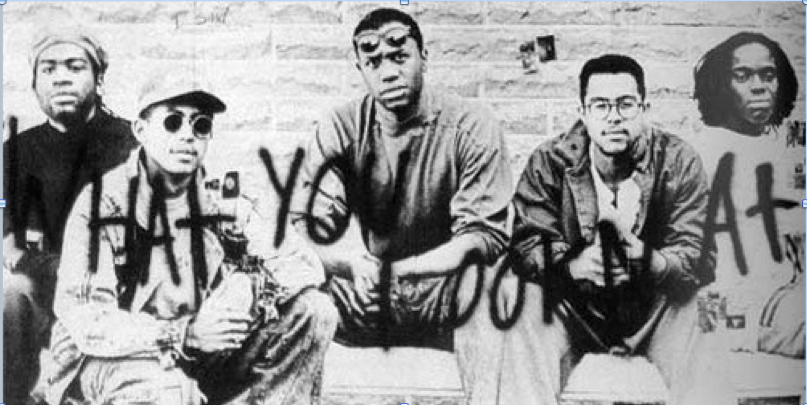
What You Lookin At:
Quick, peek at the image of What You Lookin At that accompanies this review. What do you see? What might you see or feel if you’re a shopper in a mall? A substitute teacher? A tourist in Jamaica? A law enforcer in Flint?
The billboard-size photograph by contemporary photographer, Pat Ward Williams, dominates the entire exhibit, “Examining Identity Construction”, currently at MW Gallery in downtown Flint. (In the gallery version, the graffiti is in bright red paint).
“What you’re looking at,” said MW Curator Stephanie James, “is five black men, well dressed, neatly groomed, that are just looking into the camera more quizzically than in a threatening manner. And what she [Ward Williams] suggests and what she was motivated by was the idea that these students could be any students, a family member.”
According to James, this work by Ward Williams “attempts to counter the negative conceptions associated with images of black men; conceptions of those men being suspicious or threatening.”
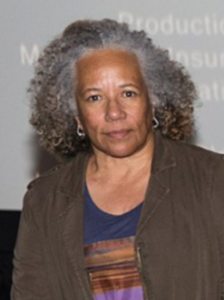
Contemporary artist, Pat Ward 2014. (Photo source: www.flicr.com)
“If we take the time to really look at individuals, to really see individuals as three-dimensional beings, as opposed to these flat stereotypes…and make determinations about a person’s character, if we take the time to explore, we’ll find so much more,” James said.
A close-up look at the work reveals that collage pieces are imbedded in the photograph that represent typical, day-to-day lives of the fairly normal young men: a wedding; family gatherings; artistic expression as represented by an easel.
Examining identity construction:
James conceived and installed the current exhibit, Examining Identity Construction, shortly before the pandemic shutdown in mid-March and two months before the murder of Floyd.
“So few people got to see it,” said James. So she has extended the exhibit initially through this month, and now through Jan. 23.
“Identity politics and examination of identity construction—how one identifies or is identified—has been a subject that so many contemporary artists have been pursuing,” James said.
“In our multicultural society, the conception of identity is ever-evolving. It started off as a reference to physical and visual attributes–height, weight, hair color, eye color–things of that nature.
“But it’s exploded,” she said, “and is informed by race, gender, sexual orientation, religion, political affiliation, economic class and more.”
James subdivided the exhibit into three themes or threads that included: Confronting Racist Stereotypes; Everyday People; Taking a Stand. She suggested touring the exhibit in that order “to experience a progression of imagery.” By virtue of its size alone, WHAT YOU LOOKIN AT, dominates the third section of the exhibit, Taking a Stand.
Confronting racist stereotypes:
Many of the images in the exhibit section titled Confronting Racist Stereotypes, originated with cartoon characters and blackface minstrelsy from the 1930s and 1940s.
“In many cases, the artists have appropriated racist stereotypes that have existed throughout American history (especially) in the 19th and early 20th centuries,” explained James. “They have appropriated these images as a way of responding to America’s racist past and as a way of trying to reckon with that history.”
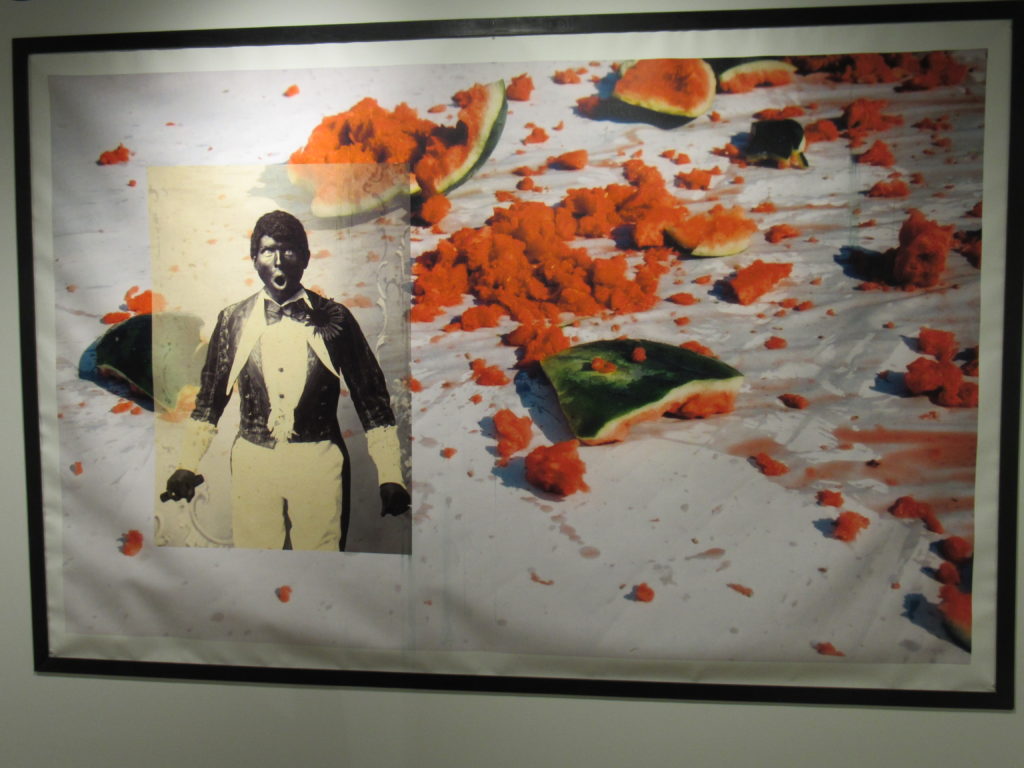
Again, the sheer size of Mark Steven Greenfield’s Oops! There it is! dominates this section of the exhibit. The visitor will see a photographic image of a white male in blackface imposed on a larger image of splattered watermelon pieces.
Steven Greenfield “brings the images together with a bit of wit and satire,” explained James. “He feels the only way to neutralize the hatefulness of violent imagery…is to confront them, to sort of take possession of them so that he (Steven Greenfield) is the manipulator.”
“My work concerns itself with the complexities of the African American experience in contemporary society,” explains Steven Greenfield per the exhibit card that accompanies the piece. “The work often involves my interpretation of the process by which images are forced in the subconscious. It is my contention that we borrow from this subliminal well on the conscious levels and alternatively navigate through various layers of consciousness to reach the source of our spiritual selves.”
Everyday people:
“These are images of everyday people, in contrast to the false depictions that were presented in some of the black stereotypes,” explained James. “These (artists) were concerned with depicting…three-dimensional people, not caricatures.”
Whitfield Lovell’s Rumor stands out, both literally and figuratively. An actual chair is attached to wooden planks that become the “canvas” for a charcoal and Conte crayon sketch of a woman in waiting.
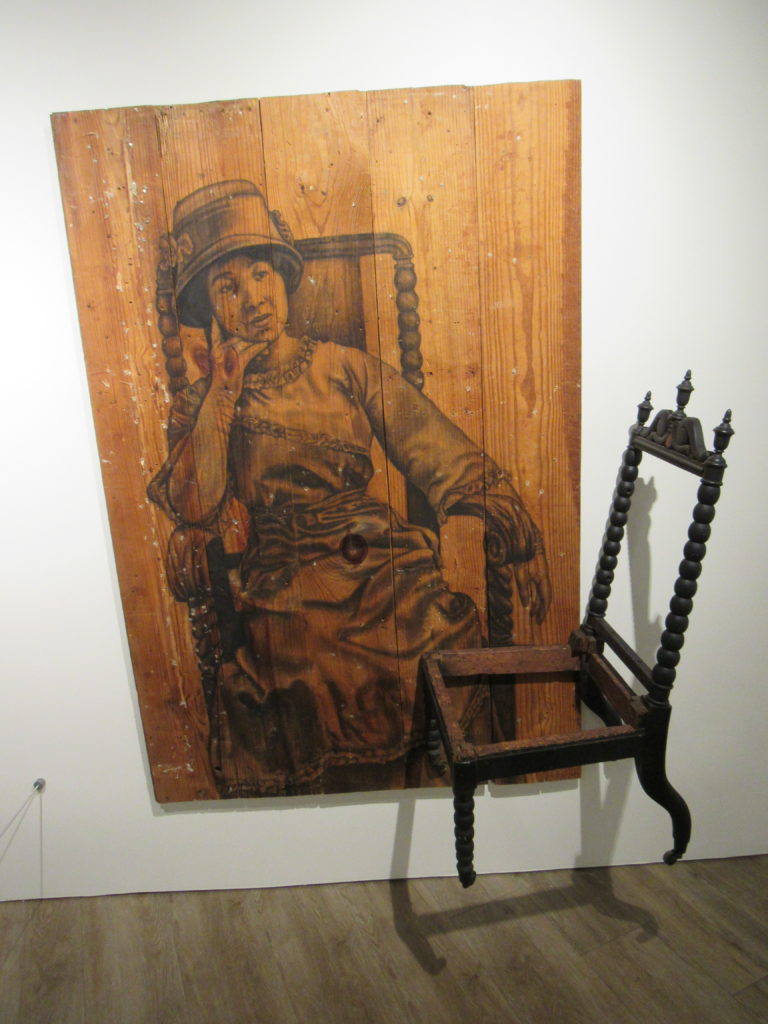
“Who is the woman waiting for to occupy the chair?” mused James. “Who might the visitor be? What’s the association?”
“When I was doing this, I was thinking about community,” explains Lovell per the exhibit card, “the chair representing the people out there who make up your community.”
The role of art:
Author Toni Morrison wrote about the role of art during a time of crisis. “This is precisely the time when artists go to work,” she wrote in Nation Magazine. “We speak, we write, we do language. That is how civilizations heal.”
“I strongly believe there is a role for art in that healing…in perhaps moving people out of complacency, but mostly by way of creating dialogue,” James said of art’s role in the nation’s current racial reckoning. “People might be more receptive to revelation through art than conversation.”
Jim Crow Museum of Racist Memorabilia:
Not to be missed during a tour of the current exhibit at MW Gallery, is a 22-minute film tour of the Jim Crow Museum of Racist Memorabilia at Ferris State University in Big Rapids, Mich. The film is found in the Confronting Racist Stereotypes section of the MW exhibit.
David Pilgrim, the museum’s founder and curator, serves as your guide and narrator for the 2013 film. Many of the images contained in the film are provocative and difficult to watch.
Better yet would be a safe visit to the museum that now o
wns 9,000 pieces. Big Rapids is little more than a two-hour drive from Flint.
* * * * *
Currently, open hours for MW Gallery, located at the corner of Saginaw St. and E. Court St. in Flint, are: Thursdays and Fridays, 11 a.m.-6 p.m.; Saturdays, 11 a.m.-5 p.m. MW is open until 9 p.m. on the 2nd Friday of each month. Due to uncertainties caused by the coronavirus pandemic, call ahead at 810-835-4900, or visit the website. Current guidelines and requirements for a safe visit are posted at the MW website. The show is being extended through Jan. 23, 2021.
EVM Staff Writer Harold C. Ford can be reached at hcford1185@gmail.com.

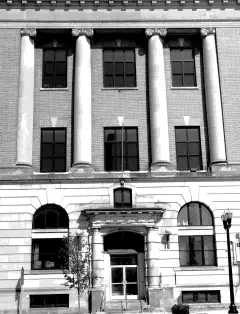
You must be logged in to post a comment.